A serene journey down the Mekong on a new luxury ship
By Penny Watson
In the classic Australian movie, The Castle, lead character Darryl Kerrigan poses that immortal question: “How’s the serenity?″
A voyage, then, aboard a floating castle, of sorts, along the Mekong River in South-East Asia can’t help but remind Australians of the film (well, at least anyone over 40).
How’s the Serenity? I’m here to find out. We’re talking the Mekong Serenity, APT’s newest cruise ship, a luxury 92-metre, 44-cabin vessel that completed its maiden voyage late last year.
This new rivership is now the decadent berth of anyone embarking on APT’s Vietnam-Cambodia Mekong cruises, such as the flagship 11-day “Spiritual Cambodia and the Mekong” voyage, which includes Siem Reap and the ancient city of Angkor.
I’m aboard the APT Mekong Serenity on an itinerary with the promise to go a little deeper on local life by stopping at lesser-known places along this mighty river. It’s a lovely feeling to board a new ship with a fresh, up-to-date interior.
Serenity’s look is “contemporary Asian fusion sophistication”, which I believe translates as a modern look (throw cushions, couches in a mix of fabrics, high-sheen timber floors), accented by Cambodian and Vietnamese motifs and artefacts.
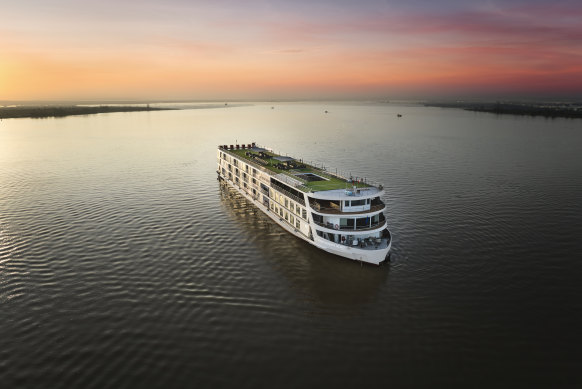
Serenity on the Mekong.
The Serenity has four decks including a turfed top deck, for sunset drinking, exercising and lounging. The lower decks have cabins, and two restaurants – Lemongrass, and the more intimate Indochine for special occasions. Harmony Lounge, a relaxed space with a bar, couches and low-slung tables, is the place for lectures and the daily 6pm “Captain’s Briefings” that accompany evening drinks. An outdoor area on the third deck has alfresco dining and recliners either side of a waist-deep plunge pool and there’s even a one-room spa for massages on the lower deck.
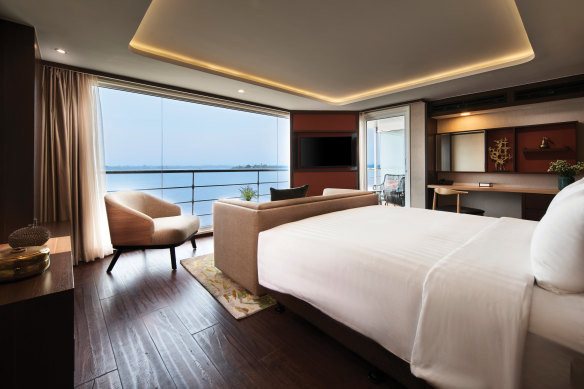
Serene by name and nature … Bayon Suite.
The suites come in three sizes and seven price categories depending on the deck. All are thoughtfully laid out with little lounge areas and private outdoor balconies. My Bayon suite, the second largest room category, is bigger than most hotel rooms with an entry that has cupboards, shelves, a mini bar, plus space to lie a suitcase flat. A queen bed faces big river-view windows, and a coffee table area accesses the outdoor balcony, from where the watery views are at their best. The river scenery is visible also from the bathtub in the ensuite (though in tropical climes I am never cold enough for a hot bath).
The journey departs about two hours south of Ho Chi Minh City at My Tho, a port town on the Mekong Delta. It is a fitting environment to start a river journey. The Mekong is the world’s 12th largest river rising from its headwaters in the Tibetan Plateau and flowing almost 5000 kilometres through south-west China, Myanmar, Laos, Thailand, Cambodia and into Vietnam’s Mekong Delta, which is one of the biggest deltas in Vietnam covering about 40,000 square kilometres. In Vietnam, the river can be as wide as one kilometre and 20 metres deep. It’s almost double that depth on the Cambodian border.
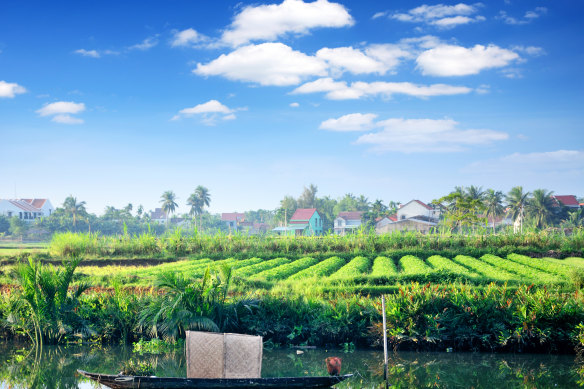
Mekong scenes.Credit: iStock
Thirty or so tourist ships cruise up and down the Mekong between Vietnam and Cambodia but the real story, and scenery, is the window onto the daily lives of the millions of people whose livelihoods depend on the river. On the delta’s many islands and along the web of estuaries, canals and waterways, aquaculture and agriculture intermingle. Fields of flooded rice paddies, and crops of mango, durian, jackfruit, pomelo and mangosteen nod to the local export industries. Floating family homes sit above caged shrimp and fish farms, their small “catches” offloaded to big co-ops and sold internationally.
As Hung, one of our guides is at pains to point out, the sediment and silt, which gives the Mekong its chocolaty hue, is rich in nutrients so that the dramatic waters that flood the land during the monsoon season are a veritable life force, feeding the soil and the crops.
“It’s not clean and clear like the Danube,” he says. “And it’s not meant to be”.
Whether from my private balcony, a poolside recliner or the dining room, I am riveted by the Mekong’s tantalising, ever-changing visual feast.
Barges ferry cargo and food, up and down the river, their cumbersome hulls sitting heavy in the wash. Charming wooden boats with painted beady eyes are piled with logs headed to construction sites. Local ferries, their sides strung with orange life rings, taxi passengers across the river, the karaoke tunes carrying across the water to my willing ears.
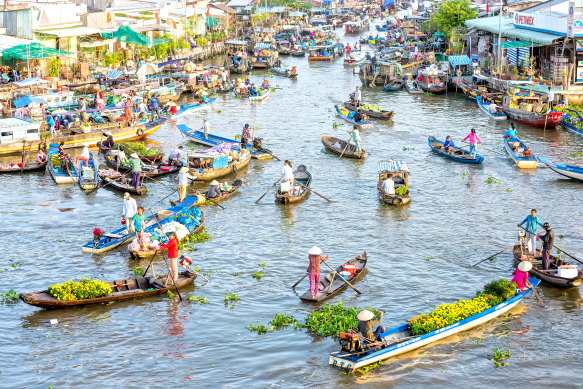
A floating market on the river.Credit: iStock
Our itinerary includes one or two riverside excursions each day either from traditional wooden sampan vessels or direct from ship to the riverbank. We visit Cai Be, a port town with a colonial past and wander around the Roman style Catholic cathedral with its tower bells cast in France in 1931. In Sa Dec, we walk through street markets where squatting fruit sellers offer us slices of durian “the king of fruits”.
On Evergreen Island, we visit the ornate wooden house of a couple who tell their story of being moved, as educated city intellectuals, to rural Vietnam to be re-educated in agriculture after the Vietnam War. Their garden dangles with Vietnamese culinary staples: jackfruit, tamarind pods, wing beans and custard apples.
Back onboard, daily activities are designed to complement the day’s excursions. We watch as the chef cooks goi cuon (Vietnamese rice paper rolls) and pho bo (beef noodle soup) after our market visit, and tune into a documentary about Cambodia as The Serenity cruises toward Phnom Penh. Trinh Ngoc Thanh, otherwise known as Tim, our kind-hearted and soft-spoken tour director from Hanoi, gives nightly briefings that combine his considerable local knowledge with Buddhist wisdom.
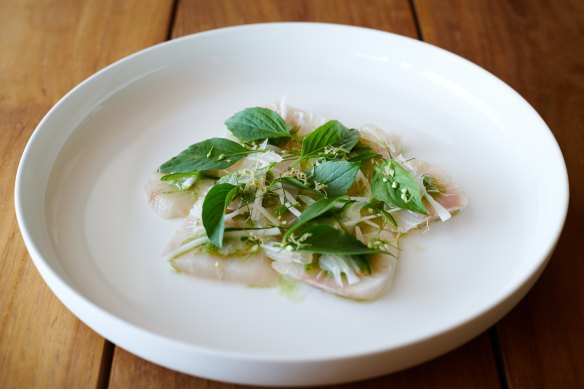
Sashimi on the Serenity.
The passing scenery keeps us occupied too. I rise early on day four as Phnom Penh comes into view. The Cambodian capital’s pinky cloud-washed metal skyscrapers rise on the horizon and the golden stupas and Silver Pagoda palace come into sharper focus the closer we get.
In the elegant French-colonial Cambodian capital our itinerary includes the Royal Palace and National Museum or an excursion to the Killings Fields, the site of the Khmer Rouge regime’s horrendous crimes. I choose to explore the city. In the old quarter I order a trio of imported French cheeses and a glass of chardonnay in a little bistro surrounded by the city’s glorious yellow and white French colonial buildings.
Beyond Phnom Penh, we cruise closer to the banks where enormous stands of bright green bamboo pop among the darker palm and mango trees. Old wooden canoes nose the banks where goats and white humped-neck cows nibble and graze.
At Oknha Tey village we alight for a tuk tuk ride to a village to learn how thread is extracted from silkworms and then woven into exquisite bolts of fabric. At another riverside stop, we walk to Wat Hanchey hilltop pagoda where novice monks stroll around temples and stupas built in the eighth century.
Further upstream, riverside Angkor Ban is one of the few villages where pretty stilted wooden houses survived the Khmer Rouge regime of the 1970s. Its nickname, Lucky Village, is a sentiment that extends to our visit as it coincides with an annual festival. We walk down the gangplank to a town square in full party mode with a live band on stage, the tunes reverberating through the tinny speakers. I buy a banh mi from a young Cambodian for $US1. The same delicious meal, I tell him, costs 10 times that at home.
Buying food is completely unnecessary, of course. Cruises on The Serenity are all-inclusive with decent cocktails, international wine and chilled local beer available any hour of the day. Meals are equally generous. Breakfast is a full buffet spread including a station with bubbling fresh noodles while elaborate a la carte lunches and dinners feature the likes of rich Cambodian beef stews and Vietnamese sweet-and-sour soups.
Often dinner festivities continue in the Harmony Lounge until late, but on some nights Tim invites guests to join him for a meditation on the top deck. Only a handful of us make it on the final night. With the moon reflecting off the water, the sound of frogs croaking and the current trickling by, we take some big full breaths worthy of this mighty river … aah the serenity.
The writer was the guest of APT Touring.
THE DETAILS
The 11-day Spiritual Cambodia and the Mekong tour from $6295 a person. The itinerary includes a seven-night cruise aboard The Mekong-Serenity, and a sun-rise visit to Cambodia’s Angkor Wat. See aptouring.com.au
Sign up for the Traveller Deals newsletter
Get exclusive travel deals delivered straight to your inbox. Sign up now.